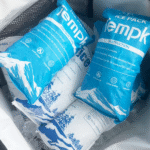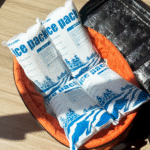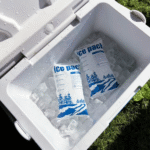Dans 2025, ensuring the integrity of temperature-sensitive shipments is more critical than ever. Que ce soit l'expédition pharmaceutique, denrés périssantes, ou échantillons biologiques, the ability to maintain a consistent, cold temperature throughout transit is paramount. Refrigerant dry ice ice packs are the leading solution, offrant un coût rentable, écologique, and reliable way to preserve your products’ temperature during delivery.

-
Comment faire refrigerant dry ice ice packs work and why are they ideal for ultracold shipments?
-
What are the key advantages of using refrigerant dry ice ice packs in cold chain logistics?
-
How can you maximize the use of dry ice ice packs for your specific shipping needs?
How Do Refrigerant Dry Ice Ice Packs Work?
Refrigerant dry ice ice packs are designed to keep products cold by leveraging the unique sublimation process of dry ice, which transitions directly from solid to gas. Unlike traditional ice that melts into water, dry ice remains dry, preventing moisture-related damage to sensitive items. Quand il est gelé, the packs absorb and retain cold, releasing it gradually to maintain a consistent temperature.
For products that need to remain frozen (Par exemple, vaccins, biologique, ou fruits de mer gelés), refrigerant dry ice ice packs maintain temperatures as low as –78.5°C, offering unmatched cooling power for extended periods (24-72 hours depending on packaging and insulation). This makes them a preferred choice over gel packs or foam bricks, which are limited to moderate cooling ranges.
Cooling Ranges Compared
| Cooling Agent | Plage de température | Durée | Key Advantage | Common Use |
|---|---|---|---|---|
| Glace sèche | –78.5°C to –60°C | 24–72 hrs | Ultra-froid, Pas de résidu | Aliments surgelés, vaccins, biologique |
| Packs de gel | –20°C to +8°C | 24–96 hrs | Réutilisable, température régulière | Médicaments, chilled foods |
| Foam Bricks | –10°C to +4°C | 48–72 hrs | Économique, empilable | Produce, laitier, médicaments |
| Glace ordinaire | 0°C to –2°C | 6–12 hrs | Faible coût, parcours courts | Non-critical goods |
Key Benefits of Using Dry Ice Ice Packs in Shipping
1. Enhanced Cooling Efficiency
Dry ice provides extended cooling capabilities, ensuring that products remain within the required temperature range for the entire duration of the shipment. Its ability to keep items colder for longer periods compared to traditional methods makes it ideal for perishable goods, especially for industries like pharmaceuticals, biotechnologie, and food.
2. Rentabilité
While dry ice may have a higher initial cost compared to traditional ice packs, its efficiency in cooling results in reduced overall shipping expenses. Less dry ice is required to maintain lower temperatures, leading to lower freight costs and minimized spoilage rates.
3. Écologique et sûr
Dry ice sublimates into gas and leaves no liquid residue, which eliminates the environmental concerns associated with melting ice. En plus, dry ice is non-toxic and poses no significant environmental risks, making it a safer alternative to traditional ice for shipping temperature-sensitive goods.
4. Versatilité
Dry ice ice packs are used across multiple industries, y compris les produits pharmaceutiques, nourriture, commerce électronique, et biotechnologie. From maintaining vaccine efficacy to preserving the quality of frozen food products, they offer a versatile and reliable solution for any temperature-sensitive shipping need.
How Can You Maximize the Use of Dry Ice Ice Packs?
1. Assess Your Product’s Temperature Requirements
Determine whether your products need to be kept frozen or just chilled. Pour les produits surgelés, La glace sèche est la meilleure option, but for items that only need moderate cooling, gel packs or foam bricks might be more cost-effective.
2. Optimize Packaging and Insulation
Maximize the efficiency of dry ice by using high-quality insulation. Panneaux isolés sous vide (VIP) can reduce dry ice consumption by up to 25%, extending the duration of cooling and improving overall logistics efficiency.
3. Work with Trusted Logistics Providers
Partner with experienced logistics companies who specialize in dry ice shipments. They will ensure your products are handled with care, reducing the risk of temperature fluctuations that could lead to spoilage.
Exemple pratique:
A pharmaceutical company successfully shipped temperature-sensitive vaccines using dry ice, ensuring the vaccines stayed at the correct temperature upon arrival, maintaining their effectiveness and preventing spoilage.
2025 Trends in Cold Chain Logistics and Dry Ice Use
Smart Technology Integration
Dans 2025, technology integration continues to revolutionize cold chain logistics. Real-time tracking sensors, Systèmes de surveillance de la température intelligente, and automated logistics systems are being adopted to ensure that shipments are accurately tracked and handled.
Efforts de durabilité
As sustainability concerns grow, companies are increasingly turning to eco-friendly dry ice sources and packaging solutions. Businesses are adopting sustainable practices like reusing dry ice and integrating phase-change materials (PCMS) to further reduce their carbon footprint.
Conformité réglementaire
Stricter regulations are being enforced globally, particularly for pharmaceuticals and food products. Dans 2025, ensuring compliance with temperature-sensitive shipping standards (such as IATA and DOT regulations) will be critical. Packaging solutions like dry ice ice packs that adhere to these standards are more important than ever.
Questions fréquemment posées
Q1: How much dry ice should I use for my shipment?
For every 10–15 pounds of product, 5–10 pounds of dry ice is typically recommended per 24 heures de transit. Adjust based on the specific temperature needs and packaging.
Q2: Can dry ice be used for all types of shipments?
Oui, dry ice is effective for shipping a wide range of temperature-sensitive products, y compris la nourriture, médicaments, et les matériaux biologiques.
Q3: La glace sèche est-elle sûre à manipuler?
Dry ice is generally safe to handle with proper precautions. Always wear insulated gloves and ensure proper ventilation to avoid pressure buildup.
Conclusion et recommandations
Dans 2025, refrigerant dry ice ice packs are indispensable for ensuring the safe transport of temperature-sensitive goods. Their superior cooling efficiency, rentabilité, and environmental benefits make them the preferred solution in industries like pharmaceuticals, nourriture, et le commerce électronique.
Étapes d'action:
-
Evaluate your products’ temperature needs and select the appropriate refrigerant (dry ice for frozen, gel packs for chilled).
-
Work with trusted logistics partners and optimize your packaging for maximum insulation efficiency.
-
Stay updated with the latest trends and innovations in cold chain logistics to remain competitive.
À propos du tempk
Et tempk, we specialize in innovative cold chain solutions that cater to your shipping needs. Our expertise in dry ice and gel pack solutions ensures your perishables are delivered safely and on time, while adhering to the latest industry standards. We focus on sustainability, efficacité, and performance to help businesses stay ahead in the logistics game.
Appel à l'action: Contact Tempk for expert advice on enhancing your cold chain logistics with our tailored refrigerant solutions. We help you optimize shipping efficiency, réduire les déchets, and meet your regulatory requirements.























